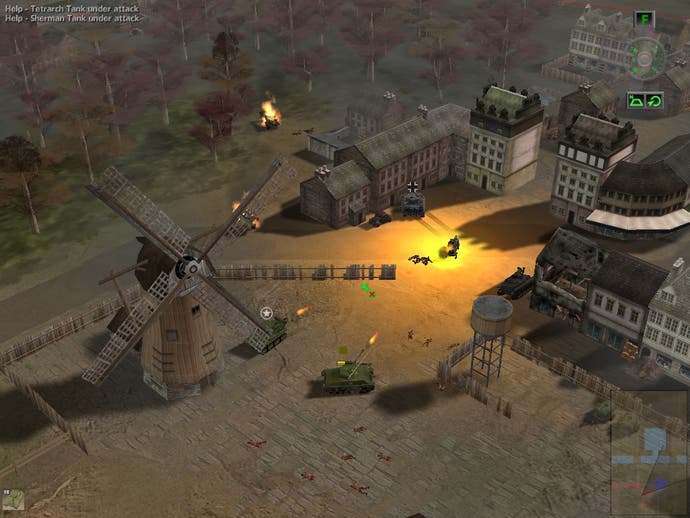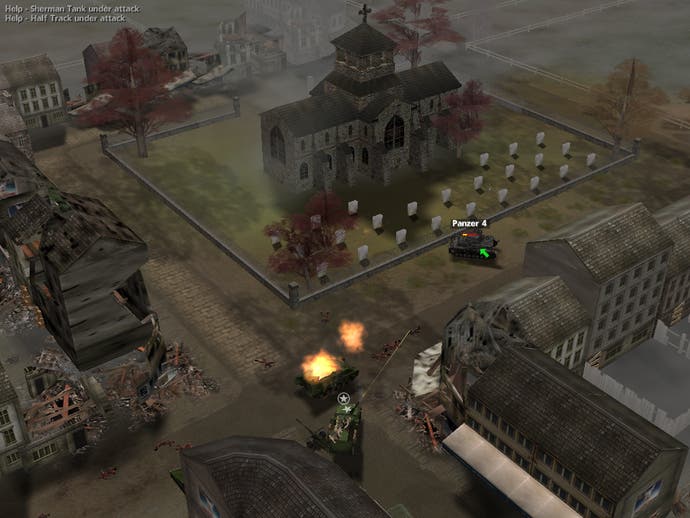World War II: Frontline Command
The Bitmap Brothers are back with one of the best reasons to embrace World War II since MOHAA.
If there's one activity which has proved immensely popular among gamers [well, focus groups at least -Ed] over the past year or so, it's getting up close and personal with the battles of World War II - both real and imaginary. From the epic warfare of Battlefield 1942 to the covert missions (well, as covert as you can get when you kill everything that moves) of Medal of Honour and beyond that to the Nazi bondage babes and zombies of Return to Castle Wolfenstein, the second world war is definitely the combat zone du jour. It's a bit surprising, then, that nobody has done a convincing, mainstream strategy game based in this era - until now.
No, we're not forgetting the Sudden Strike games - we're just not convinced that they count as mainstream, being excellent titles but mostly enjoyed by hardcore strategy buffs. The fact is that while PC RTS games have moved into all-singing all-dancing 3D over the last few years, generally polishing their user interfaces and presentation along the way, World War II games have, to a large degree, remained stuck in the past.
War is Hell, but it does look good

There are two things you need to know about World War II: Frontline Command from the outset, then. The first is that it's a gorgeous looking 3D strategy game which aims to bring WW2-era strategic combat kicking and screaming into the 21st century; the second, perhaps more importantly, is that the people behind it are legendary UK development studio The Bitmap Brothers, a team that not only has some rather superb classic games to its name, but also has more than a little experience of writing strategy titles with mainstream appeal - the last two major games to emerge from the studio were innovative RTS titles Z and Z 2.
The first thing you'll notice about Frontline Command is the graphics, which are easily a match for any other strategy game we've seen on the PC recently. Everything is presented in high-detail, fully rotatable 3D, and many players will be happy to find that there's a wide range on the in-game zoom - so you can get up close to your units and admire the well-designed models, detailed environments and dynamic lighting effects, or you can pull out a long way to get a proper overview of the extensive battlefield. One could level a charge of lack of variety at the game when it comes to environments - every level consists of fields, hedgerows, farmhouses and bombed-out villages and factories - but the campaign represented in the game is the Northern European campaign from just prior to D-Day up until VE-Day, so it's hardly surprising that the locations in the game look like Northern Europe.
Occasionally the game does throw up a "special" level - such as the D-Day landings early in the game, or the Battle of the Bulge later on - which shows up just what the engine is capable of. Marching your men up Utah beach under withering machine gun fire, towards the towering cliff-top bunkers and massive Channel Gun, is a perfect example of why graphics really are important in a game like this; you simply couldn't achieve that kind of experience without the fantastic engine at Frontline Command's disposal. By way of comparison, this is graphically a more impressive game than any other RTS title we've seen with the possible exception of C&C Generals - and even Generals lacked a lot of the lighting effects and unit detail on offer in Frontline Command. Not to mention that Frontline Command runs smooth as silk on machines which Generals gave chugging fits to...
Tiger, Tiger, Burning Bright

In gameplay terms, there's one thing to get straight from the outset - this is a resource-less strategy title, so you won't find yourself constructing buildings, mining the hedgerows of Europe for, er, turnips (or whatever) or training hardened troops at your hastily-constructed barracks in minutes. You start each level with a complement of units - various kinds of infantry, light and heavy armour, field guns and whatnot - and barring the occasional appearance of reinforcements on some maps, that's your lot. As you might expect, this encourages you to treat your forces rather more carefully than you would otherwise - if other RTS games are Quake, with the whole "get a unit killed and build another one instantly" mentality, then this is Counter-Strike, where the dead stay dead and losing a man at the wrong time can spell disaster for the whole operation.
Thankfully, there's an extremely detailed and flexible combat model present in Frontline Command which means that casualty-heavy grunt rushes are real amateur day stuff - in fact, you'll often be able to take out superior enemy forces with no casualties on your side if you play your cards right, which is an extremely satisfying experience. Much of this is down to the advanced line of sight system employed by the game, which takes into account not only all the obstacles on the battlefield, but also the height and stance of your units - so for example, infantry standing up can see over a low wall, but lying prone behind it they can't see the other side, and equally can't be seen by the enemy (and we're pleased to report that the enemy AI hasn't been caught cheating with the line of sight system even once while we've been playing the game).
This can make gameplay into a fraught experience - particularly on levels which feature a lot of small fields and tall hedgerows, because as your troops wriggle through the hedges you have no idea whether the field on the other side will be a bare expanse of lush grass, or teeming with enemy soldiers and armour keen to fill you with hot bits of exploding metal. However, it also offers excellent opportunities for ambushes, such as positioning a few engineers (chaps with TNT charges and anti-tank rockets) lying prone next to a road, waiting to hear the rumble of a tank passing by, and then popping up to take it out with a barrage of well placed shots. Manipulating line of sight is one of the core elements of gameplay - what you can't see, you can't shoot - and the commander unit, with his powerful binoculars, is useful for exactly this purpose. Sneak him to the top of a rise overlooking an enemy encampment and use him to spot for your mortar crews safely tucked away on the other side of the hill - now there's teamwork.
Tanks a million

The unit balance of Frontline Command will take quite a bit of getting used to for most players used to conventional RTS games. The Bitmap Brothers have (wisely, in our estimation) chosen to eschew the traditional scissors-paper-stone model of balancing in strategy games, and instead have given each unit on the battlefield a close approximation of its actual historical combat strength. The research which has gone into this is very detailed indeed in places - armoured units, for example, have different armour thicknesses over their bodies, so rockets will have much more impact when fired into a less armoured bit. This does certainly have the effect of making tanks into the undisputed kings of the battlefield - a couple of Panzers will chew up wave after wave of infantry, so unless you can match them evenly with your own armour, you'll need to give very careful thought to taking them out without sustaining massive losses.
Things get even more interesting once you graduate from the "Recruit" missions of the game and progress to the "Veteran" missions (you can play the Veteran missions right from the outset, but we really don't recommend it). Here, you'll find that your infantry units no longer regenerate health quickly after being wounded, and worse, they don't have unlimited supplies of ammunition - so you'll need to resupply them regularly. The Veteran mode also introduces a system of critical hits which can cripple a unit mid-battle, necessitating a quick visit from a resupply truck for a battlefield repair.
The game does also have a morale system, reminiscent of the one found in the Close Combat games, and this is affected by pretty much the factors you'd expect - achieving objectives and taking out enemy units boosts morale (as does the presence of a commander unit), while getting shot, your squadmates getting shot, or being stuck alone in the middle of unfriendly territory will sap it. Morale affects the combat effectiveness of your troops, although thankfully they'll never actually stop obeying orders outright no matter how low it goes.
Dulce et Decorum Est?

In the final analysis, the Bitmap Brothers have undertaken a surprisingly difficult task - namely, creating a realistic World War II strategy game which will appeal to the mainstream without alienating hardcore strategy fans - and have succeeded on almost every level. The game isn't without its niggles - the tendancy of engineers, who have very long reload times, to waste their rockets on infantry targets when you'd rather prefer them to save them for the King Tiger around the corner is infuriating at times - but of all the RTS titles we've played recently, it's by far the most in-depth and complex. The ability to build up genuinely clever strategies and plan ambushes and assaults in detail is one that's surprisingly absent from most mainstream RTS titles, perhaps because it's so difficult to make it accessible for casual players.
That, then, is the real triumph here; an RTS game that allows you the ability to do very complex things but doesn't have an interface which it'll take weeks to learn. You can be happily flying through the game within minutes of installing it thanks to one of the best thought-out RTS interfaces ever, and building up clever strategies can be done without resorting to some evil, over-complex menu system full of incomprehensible icons.
Strategy fans who like the Sudden Strike school of gaming will love Frontline Command immediately, and there's absolutely no question that you should run out and buy it right away - it's a game which simply must be a part of your collection. For the less hardcore strategy fans among you, don't pass by this game just on the basis of its real-world setting or lack of resource management - there's a vast amount of quality entertainment here for fans of any sort of strategy gaming.

